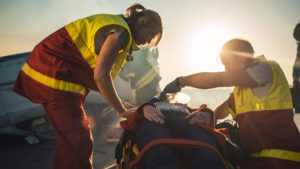Operation Lifesaver Has Greatly Reduced Crossing Fatalities
Highway-rail grade crossing accidents claim the lives of hundreds of people each year. But the number of fatalities would be substantially higher were it not for Operation Lifesaver. Operation Lifesaver was established in 1972, and since its inception, rail crossing fatalities are down more than 80 percent. Rail grade crossing accidents as a whole have also dropped significantly. Thirty years ago, there were nearly 9,500 crossing accidents. During the past year, there were less than 2,000.
Operation Lifesaver is a non-profit, international continuing public education program whose mission is to end collisions, deaths and injuries at places where roadways cross train tracks, and on railroad rights-of-way. Operation Lifesaver works to accomplish its lifesaving goals through free safety presentations designed for various professions and all age groups. Certified and trained volunteer speakers provide these presentations in all 50 states as well as in Canada, Mexico, Argentina, England and Estonia.
NTSB Chairman Wants to Build on Success and Reduce Fatalities Further
National Transportation Safety Board Chairman Deborah A.P. Hersman commended Operation Lifesaver for its mission and success thus far, but she wants to reach even higher. “We rely on the great work of organizations like Operation Lifesaver to apply commonsense, life-saving solutions at the grassroots level throughout our country,” said Chairman Hersman, “but for all the remarkable progress that’s been made in [Operation Lifesaver’s] 38-year history, there is much more work to be done.”
Chairman Hersman identified three factors as contributing to virtually all crossing accidents. Those factors include the vehicle, the environment or the driver. Out of those three factors, more than 90 percent of grade crossing accidents occur because of the driver. A number of issues can lead to driver problems, including distraction or inattention from phone calls or text messages as well as GPS navigators that give drivers a false sense of security. The Safety Board has issued several recommendations as a result of its investigations on a variety of accidents. But the Safety Board cannot achieve results on its own, which is why the work of Operation Lifesaver is so crucial.
Can Even More Lives Be Saved?
Operation Lifesaver has achieved enormous success in reducing the number of crossing fatalities, but as highlighted by Chairman Hersman, it cannot be content with its results. Operation Lifesaver performs an invaluable function and its educational programs should continue to reduce fatalities. However, in order to continue to reduce fatalities it must scrutinize the Safety Board’s investigations and work to address the threat of new technologies that compete for the attention of drivers everywhere. If Operation Lifesaver continues its important work, there is every reason to believe that the number of highway-rail grade crossing fatalities can be reduced even further.













Comments for this article are closed.